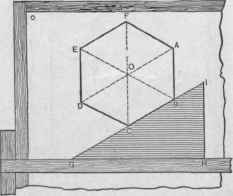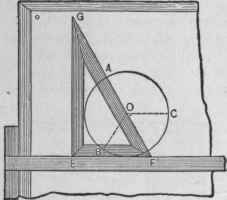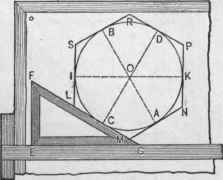The Construction Of Regular Polygons By The Use Of T-Square And Triangles Or Set-Squares. Part 4
Description
This section is from the book "The New Metal Worker Pattern Book", by George Watson Kittredge. Also available from Amazon: The new metal worker pattern book.
The Construction Of Regular Polygons By The Use Of T-Square And Triangles Or Set-Squares. Part 4

Fig. 192. - To Draw a Regular Hexagon upon a Given Side.

Fig. 193. - To Draw a Regular Octagon upon a Given Side.
56. To Draw an Equilateral Triangle about a Given Circle. - Tn Pig. 194. let 0 be the center of the given circle. Place the edge K F of a 30-degree set-square against the T-square, as shown, and more it along until the edge F G meets the center O, and mark the point A upon the circumference of the circle. Reverse the set-square, still keeping the edge E F against the T-square. and in like manner mark the point B. Move the T-square upward until it meets the point O, and mark the point O. The required figure will be described by drawing lines tangent to the circle at the points A, B and C, which may be done in the manner Following, as indicated in Fig. 195 Place the edge E G of the set-square against the T-square, and slide it along until the edge F G touches the circle in the point B. Draw I K indefinitely. Reverse the set-square, keeping the same edge against the T-square, and move it along until its edge F G touches the circle in the point A, and draw I L, intersecting I K in the point I. the other end being indefinite. Then, placing the edge F E of the set-square against the T-square, bring its edge K G against the circle in the point C, and draw L K, intersecting I D in the point L and I K in the point K, thus completing the figure. The first part of this operation is not really necessary. The sides of the set-square simply can be brought tangent to the circle, as in Fig. 195.

Fig. 194.

Fig. 195. To Draw an Equilateral Triangle about a Given Circle.
57. To Draw a Hexagon about a Given Circle. - In Fig. 196, let O be the center of the given circle. Place the edge E F of a 30-degree set-square against the T-square, and slide it along until the edge F G meets the point O, and mark the points B and A. Reverse the set-square, still keeping the edge E F against the T-square, and in like manner mark the points C and D. Bring the edge of the T-square against O, and mark the points I and K. Then C, A, K, D, B and I are six points in the circuinference of the circle, corresponding to the six sides of the required figure. The hexagon is completed by drawing a side tangent to the circle at each of these several points, which may be done by using the set-square as follows, and as shown in Fig. 197. With the edge E G of the set-square against the T-square, bring the edge F G against the circle at the point C, as shown, and draw L M indefinitely. Reverse the set-square, and in like manner bring it against the circle at the point A, and draw M N, cutting L M in the point M, and extending indefinitely in the direction of N. Slide the set-square along until the edge E F meets the circle in the point K, and draw N P, intersecting M N in the point N, and extending in the direction of P indefinitely. With the set-square in its first position slide it along until the edge F G meets the circle in the point D, and draw R P, cutting N P in the point P, but being indefinite in the direction of R. Reverse the set-square, and in like manner draw R S tangent to the circle in the point B, cutting P R in the point R, and extending in the direction of S indefinitely. Slide the set-square along until its edge E F meets the circle in the point I, and draw S L, cutting R S in the point S and L M in the point L, thus completing the required figure.

Fig. 196.

Fig. 197. To Draw a Hexagon about a Given Circle.

Fig. 199.

Fig. 199. To Draw an Octagon about a Given Circle.
In this problem, as in the previous one, if care be taken the first part of the operation can be dispensed with by simply placing the triangle in proper position and drawing the sides of the figure tangent to the circle, as shown in Fig. 197.
58. To Draw an Octagon about a Given Circle. - In Fig. 198, let O be the center of the given circle. With the edge E F of a 45-degree set-square against the T-square, as shown, move it along until the side E G meets the point O, and mark the points A and B. Reverse the set-square, and in like manner mark the points C and D. Slide the set-square along until the vertical side G F meets the point O, and mark the points H and I. Move the T-square up until it meets the point O, and mark the points K and L. Then A, I, D, L, B, H, C and K are points in the circumference of the given circle corresponding to the sides of the required figure. The octagon is then to be completed by drawing lines tangent to the circle at these several points, as shown in Fig. 199, which may be done by the use of the set-square, as follows: With the edge E F of the set-square against the T-square, as shown, bring the edge E G against the circle in the point D, and draw M N indefinitely. Sliding the set-square along until the vertical edge F G meets the circle in the point L, draw N P, cutting M N in the point N, and extending in the opposite direction indefinitely. Reverse the set-square, and bringing the edge E G against the circle in the point B, draw P R, cutting N P in the point P, and extending indefinitely in the direction of R. Move the T-square upward until it meets the circle in the point H, and draw the line S R, meeting P R in the point R, and extending indefinitely in the opposite direction. Then, with the set-square placed as shown in the engraving, move it until its edge E G meets the circle in the point C, and draw S T, meeting S R in the point S, and continuing indefinitely in the direction of T. With the set-square in the same position, move it along until its edge G F meets the circle in the point K, and draw T U, cutting S T in the point T, and extending in the opposite direction indefinitely. Reverse the set-square, and bringing its long side against the circle in the point A, draw U V, cutting T U in the point U, and continuing indefinitely in the opposite direction. Bring the T-square against the circle in the point I, and draw V M, connecting U V and M N in the points V and M respectively, thus completing the figure. The above rule will be found very convenient for use, although, as the student may discover, the first part of the operation is not absolutely necessary.

Fig. 200. - To Draw a Square about a Given Circle.
59. To Draw a Square about a Given Circle. - In Fig. 200, let O be the center of the given circle. Place the blade of the T-square against the point O, and draw the line A O B. With one of the shorter sides E F, of a 45-degree set-square against the T-square, and with the other short side against the point O, draw the line DOC. Move the T-square upward until it strikes the point C, and draw the line H C I. Move it down until it strikes the point D, and draw the line EDK. With the side E F of the set-square against the T-square, as shown in the engraving, bring the side E G against the point A, and draw E A H. In like manner bring it against the point B, and draw K B I, thus completing the figure. It is to be observed that the several lines composing the sides of the square are tangent to the circle in the points A C B and D respectively. The only object served by drawing the diameters A B and C D is that of obtaining greater accuracy in locating the points of tangency.

Fig. 201. - To Draw a Square upon a Given Side.
60. To Draw a Square upon a Given Side. - Let A B of Fig. 201 be the given side placed parallel to one side of the drawing board. Place one of the shorter edges of a 45-degree set-square against the T-square, as placed for drawing the given side, and slide it along until the long edge touches the point A, and draw the diagonal line A C indefinitely. Place the T-square so that its head comes against the left side of the board, as shown by the dotted lines in the engraving, and, bringing the blade against the point A, draw A D indefinitely. Then bringing the blade against the point B, draw B C, stopping this line at the point of intersection with the line A C, as shown at C. Bring the T-square back to the original position and draw the line C D, thus completing the figure. In the case of a large drawing board, unless the figure is to be located very near one corner of it, or in the case of a drawing board of which the adjacent sides are not at right angles, it will be desirable to use the right angle of the set-square, instead of changing the T-square from one side to the other, as above described. The object of drawing the diagonal line A C is to determine the length of the side C B. This also may be done by the use of the compasses instead of the set-square, as follows: From B as center, with B A as radius, describe the arc A O C. Place the T-square as shown by the dotted lines, and, bringing it against the point B, draw B C, producing it until it intercepts the arc A O C in the point C. The remaining steps are then to be taken in the manner above described.
Continue to:


